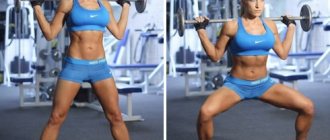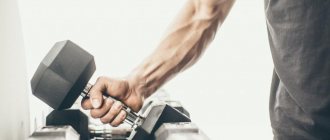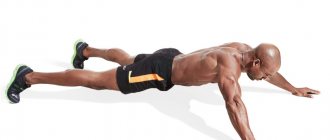In this article, you will learn how to distinguish a genetically gifted bodybuilder from an amateur, to whom nature has not given bonuses for the rapid development of a powerful bodybuilder's body.
This information will help you determine your genetics (good or bad), so that you already at the planning know all your pros and cons when doing bodybuilding.
Genetic predisposition to a particular sport is often a determining factor in becoming a champion in the professional arena.
When it comes to bodybuilding, unfortunately, only genetics will decide whether you become great (like Arnold Schwarzenegger or Ronnie Coleman) or not.
Even as a child, you probably noticed that one person is physically well developed, strong, from birth, while the other is weak, thin , with thin bones, with minimal muscle mass. And who do you think will achieve more success in bodybuilding, given the same training and nutrition? Of course the second one. This is the so-called genetic predisposition to bodybuilding, when a person’s body type, structure and attachment of muscles favors exercise with weights and iron.
Let us identify the decisive genetic factors that directly affect success in bodybuilding:
- Body type
- Muscle insertion point
- Neuromuscular connection
- Length of muscle belly
- Type and number of muscle fibers
- The body's response to anabolic steroids
- Character (personal qualities)
Now let's look at each factor in more detail.
Body types (somatotypes) of people
Each of us has our own body type, which directly affects the amount of subcutaneous fat and muscle, strength and structure .
In order to determine your somatotype , you need to measure your wrist circumference. As a rule, if the measurements show from 15 to 17.5 cm , then we can say that you have fragile and thin bones, if from 17.5 to 20 cm , then you have an average bone foundation, but what if your wrist circumference will be more than 20 cm , congratulations, you have a powerful and strong bone structure.
Also, in order to navigate your body type, sometimes it helps to measure your ankle (its circumference is almost always 5-6 cm smaller than the wrist in all people). Of course, there are exceptions, both in the direction of decrease, that is, with the same size of the ankle and wrist, in this case we can say that the strength of the top and bottom is the same, and in the direction of increase (by 10-12 cm), in this case, the strength of the lower part of the body is much greater than its upper part.
Depending on his nutritional system, training and recovery program, an athlete can change his body beyond recognition. However, for some it will be easy and not forced, but for others it will be very, very difficult. That is why (according to Sheldon ), it is customary to distinguish all people into the following body types:
- Mesomorph (muscular)
- Endomorph (plump)
- Ectomorph (thin)
We have already written in more detail about each body type in the article; if you are interested in reading, please follow this link.
Body types (somatotypes) of people
It is important to understand that if you cancel proper nutrition, recovery and regular training, you will end up where you started . In this case, endomorphs will benefit the most, because they need to strictly, strictly adhere to a sports lifestyle in order to maintain their figure at a high, athletic level.
Also, I would like to draw your attention to the following factors that relate to each specific body type.
Metabolism
People with a slow metabolism are usually fat and have a lot of excess weight, while fast digestion contributes to weight loss, it will be difficult for people to gain muscle mass.
Someone can eat a lot and not gain weight due to a fast metabolism, while someone can eat an extra bun or cake and immediately gain weight . In addition, athletes absorb substances useful for muscle growth, proteins, fats, carbohydrates, vitamins and minerals, differently.
Load response
We respond to training programs differently, for some it is enough to do the bench press 2 times for the chest to grow by leaps and bounds , and for others, even with a 5-day training of the pectoral muscles, they will not get results.
Everything is individual, much depends on restorative abilities and the athlete’s fitness level. However, do not confuse beginners and experienced athletes, for the former everything is very simple, the body will grow, up to a certain point, on a universal program, since the hidden capabilities of a beginner (potential for growth in strength and muscle mass) are still very far from the limit of human capabilities .
Muscle response to force load
Bone strength
At a certain training stage, your strength results can reach their apogee , which will be determined by the strength of your ligaments, cartilage, tendons, and bones; the main thing here is not to “break” and stop in time.
As the legendary Ronnie Coleman said, if you want huge muscles, then work with heavy weights, for a large number of repetitions. And as you understand, the more weight you put on the barbell and the more repetitions you can do, the larger your muscles .
Predisposition to bodybuilding
There are several factors that indicate one degree or another of an athlete’s genetic predisposition to bodybuilding. Now we will look at them in detail.
Body composition
Everyone knows that it is customary to distinguish between three body types - mesomorph, endomorph and ectomorph. Let us remind you that they practically never occur in their pure form, but there is no doubt that each of us has one or another body type predominant. Endomorphs are less predisposed to engage in professional bodybuilding. This fact is associated with the presence of a wide waist, as well as a tendency to gain fat mass.
At the same time, they can achieve excellent results in powerlifting, because their strength indicators are high. Mesomorphs are lucky enough to have almost perfect muscles from birth. However, this body type has one drawback - a fairly wide waist, which is not very good for a builder. But this is well compensated by developed muscles.
Among the famous mesomorph athletes, Dorian Yates and Jay Cutler immediately come to mind. It is generally accepted that ectomorphs are least predisposed to bodybuilding. From birth they have thin bones and narrow shoulders. However, they are the ones who can create the ideal body. It is enough to remember Flex Wheeler to be convinced of this. It is also necessary to note Phil Heath, whose physique also largely corresponds to an ectomorph. Both builders have a narrow waist, and the shoulders can be rocked if desired.
Symmetry
An ideal body can be considered if both halves are developed symmetrically. We are talking now, as you understand, about the right and left parts of the body. To achieve this, the athlete must have a completely healthy spinal column. The presence of any, even the most minor problems with intervertebral discs will at some point lead to pinching of nerve endings. As a result, it will become impossible to develop paired muscles evenly. By the way, scientists have discovered a pattern between malocclusion and problems with the spine.
Muscle attachment sites and fiber types
If you are interested in how to find out your predisposition to bodybuilding and powerlifting, then you need to determine the points of attachment of muscles to the bone structures of the skeleton. Don’t think that this is very difficult, just do a study of your body and everything will fall into place. Scientists have proven that the lower these places are, the faster you can achieve your goal.
It is equally important to find out the number of different types of fibers in your muscle tissue. It is quite obvious that this parameter can be changed through the process of hyperplasia, but the more muscle fibers you have from birth, the easier it will be to progress. Most athletes believe that a biopsy is necessary to determine the number of fibers of all types.
However, this is not the case and you can completely do without going through this procedure. Just work in different training modes - explosive, low-volume, and also high-volume. You need to determine which muscle group gets tired faster. Let us pay attention to the fact that in this case it is not the refusal that is of interest, but fatigue.
If you get tired faster when using low-volume training, then Ma-type fibers predominate in muscle tissue. Accordingly, if this happens during explosive training, then the muscles contain more lib-type fibers, and with high-volume training - the first type. The fewer slow fibers (type 1) you have, the better. The most famous athlete whose muscle tissue was dominated by slow fibers is Canadian bodybuilder Nimrod King.
Ligaments
By and large, you can achieve outstanding results in bodybuilding without having enormous strength. However, if you work with heavy weights, then the task at hand will be solved faster. When determining strength, first of all, you need to pay attention to the ligaments with the joints.
Nutrition
One of the main factors of progress in bodybuilding is nutrition. This may sound strange, but appetite and the speed of metabolic processes are inherent in each of us from the moment of birth. For example, Victor Richards, a native of the African continent, could consume any food in huge quantities. It is quite clear that he gained weight very quickly.
During the heyday of his career, with a fairly lean physique, Victor’s body weight reached 150 kilos. Another example is Jaxter Jackson. According to the builder himself, he literally forced himself to eat food, since the guy did not have a big appetite. But thanks to his fast metabolism, he could maintain close to optimal shape for almost the entire year.
Anabolic steroids
If we talk about the use of various anabolic drugs, then professionals need them much less compared to amateurs. This fact is due to the fact that in elite athletes the concentration of testosterone and IGF is at a fairly high level. In addition, their muscles contain a large number of androgen receptors.
As a result, even minimal doses of steroids can produce a strong anabolic response. It should also be noted that professionals synthesize the protein compound myostatin much more slowly. Let us remember that this substance is designed to inhibit the growth of muscle mass. Do not forget about other enzymes, for example, 5-alpha reductase or aromatase, the concentration of which also differs from those of ordinary people.
Discipline
For those who do not yet know how to find out their predisposition to bodybuilding and powerlifting, I would like to say one thing - all your possible natural advantages will be worth absolutely nothing without discipline. To become a true professional, you need to be dedicated and selfless. Although this is important in any sport, not just bodybuilding.
An example of an almost complete lack of discipline is Chris Cormier. This is an amazingly gifted athlete from a genetic point of view, who literally squandered everything and could not achieve even half of what was possible. But, let’s say, Branch Warren, despite not having excellent genetics, achieved a lot thanks to high self-discipline.
Muscle insertion point
The strength of a muscle, if we take into account the genetic makeup of a person, will depend directly on its points of attachment .
Due to the fact that the muscle is attached to two different bones, it can produce movement.
If the beginning of the muscle, in all people, as a rule, is always located in the same place (this point is called the “ beginning of the muscle ”), then with the point of attachment of the muscle to the bone, not everything is so simple.
The attachment point is the place where the muscle group attaches to the most mobile bone. Moreover, the further the attachment point is located from the joint, the more the athlete will be able to show muscle effort .
For clarity, let's look at the biceps . One end of it begins at the same place, near the shoulder, the other end, that is, where it is attached, ends on the forearm , since it is more mobile in relation to the humerus. Thanks to this connection with the bones, when the biceps contracts, movement occurs (the forearm is pulled towards the shoulder). Accordingly, people who naturally have a biceps attachment point as low on the forearm will have greater strength by nature, with any biceps lifts.
Origin and insertion of muscle
Genetically gifted athletes for strength sports always have muscle attachment points displaced In other words, if you take two athletes with arms of the same length and triceps of the same size, then the muscle force will show more, for example, in the French bench press exercise, an athlete whose triceps attachment point is shifted further from the joint .
Even the slightest displacement of muscle attachment points will bring significant superiority over an athlete whose points are located close to the joints.
Congenital features
Let's start with the innate characteristics of the body, which do not appear outwardly, but can become the reason for certain success or failure in strength sports. For example, diseases such as asthma, arrhythmia, heart disease are diseases that can often be inherited. Let us note that if you have such innate qualities, do not despair, this will not be an obstacle to playing sports in general; you can practice and progress with such diseases.
Neuromuscular efficiency
Neuromuscular efficiency will depend on how many muscle fibers are involved, it shows how efficiently the muscles respond to signals sent from the nervous system.
The more muscle fibers participate in the work, the more effective the exercise is. That is why athletes by nature with high neuromuscular efficiency train much more productively in the gym, showing, under equal conditions, higher strength indicators .
Muscle belly length
Muscles are attached to bones by tendons . If you cut the tendon, you will be left with fleshy muscle tissue, which is called the belly (the lumps that we are all used to seeing on a bodybuilder).
If the cross-sectional area of the abdomen can be increased several times with the help of training, then, unfortunately, its length cannot. It is the last criterion for the characteristics of the abdomen, that is, its length, that allows us to tell us how much the maximum muscle size can be increased.
The longer the muscle belly, the greater the athlete’s chances of building high-quality muscle mass, both in volume and muscle thickness.
Length of Muscle Abdomen
People who naturally have short abdomens will lag significantly behind the limit of maximum muscle development (this rule applies both in relation to oneself and in comparison with other people). the calf , which lags behind in the development of many people .
No matter how much the athlete trains it, the maximum calf size set by genetics, that is, the length of the abdomen, will not change in any way. That is why many bodybuilders in the professional bodybuilding arena resort to both muscle implantation and banal synthol to give a pronounced peak, lower leg mound or other lagging muscle groups.
Type and number of muscle fibers
Depending on the number of certain muscle fibers, already at the initial stage of growing up of a young athlete, it is possible to determine his genetic superiority in a particular sport .
Type and number of muscle fibers
People who have more white (fast-twitch) muscle fibers in their body are initially the lucky ones who will gain muscle mass much easier and faster. In turn, the predominance of slow ( red ) muscle fibers gives the athlete superiority when working on endurance. Moreover, the ratio of red and white muscle fibers is given to us from birth.
Pronounced mesomorphs have a large number of white fibers, which, as we have already indicated, are responsible for hypertrophy and muscle strength. A typical ectomorph, with 1-2 years , will look the same as a mesomorph beginner, but once the latter starts training regularly in the gym, others will see his genetic superiority.
Genetics and training
I think many people know that in fitness, bodybuilding and bodybuilding (as it suits you), genetics plays a big role, meaning muscle attachment and the ratio of the length of arms and legs to the torso (I, of course, exaggerate).
But in fact, if we talk about genetic characteristics, then the matter does not end with anthropometry.
When talking about genetics in bodybuilding, we should also mean:
- work of internal organs;
- the body's responsiveness to physical activity;
- the body’s ability to function effectively on a particular diet, etc.
And I understand that for now this sounds kind of crazy, like: “Nikita, how can I control the functioning of my internal organs?”, wait a minute. Let's take it in order.
If we talk about the work of internal organs, then the first thing you need to do is TEST for the main hormones, as well as do a general blood test to understand how your body functions.
Well, that’s it for now, a retreat.
Let me lead you smoothly to scientific studies that show the influence of genetics on training and progress in general.
We are all 99.9% the same
And in general, this could be the end of the article, but then I wouldn’t be writing it now if everything was so simple.
Yes, we really are 99.9% the same, but if we look at the facts that at the DNA level we differ from chimpanzees by 1% of genes, and from mice by 8%, then in fact 0.1% for interspecies differences – that’s wow, that’s a lot.
The difference is that there are different versions of the same genes that everyone has, but they affect different qualities in different ways.
For example, there is a gene called ACTN3, which encodes the protein alpha-actinin-3. This protein, in turn, stabilizes the contractile apparatus of skeletal muscles and is involved in a huge number of metabolic processes.
This same gene can have a positive effect on explosive power in one case and a negative effect in another.
And there are 22 known genes that are different and influence athletic qualities.
And things get even more confusing when we learn that an organism can have different numbers of copies of the same gene.
For example, the gene that is responsible for amylase in our body.
Amylase is an enzyme in our pancreas that breaks down carbohydrates.
So, the more copies of this gene, the more efficiently the body breaks down carbohydrates, the lower the risk of becoming obese.
And vice versa, if you have less than 4 copies of this gene in your body, then your risk of becoming obese will be as much as 8 times higher than those who have more than 9 of these copies.
Such are the things.
Even before training begins, genetics determines up to 80% of the difference in dry mass. Remember in one of the articles I talked about how to gain lean muscle mass?
But this is all before you start training, and after you start in sports, everything becomes even more difficult...
The body's response to steroids (pharmacology)
Steroids affect people differently, that's a fact. For example, for some athletes a small dose of methane is enough to feel the effect of using this anabolic steroid , while for others a large dosage will not give anything. It all depends on the presence of free receptors that could contact the steroid molecule into a steroid-receptor complex. So it turns out that some have more free receptors in their muscles, some have fewer, some’s body responds better to steroids, some’s worse.
You can read in more detail how anabolic steroids act on humans.
The body's response to steroids
Person's character
The ability to endure muscle pain, burning sensation in the muscles for a long time, to engage in daily work on oneself, with one’s nutrition, distinguishes a champion from a non-champion, distinguishes people who will achieve success in bodybuilding and who will never achieve it.
Persistence, focus on results, to some extent fanaticism for one’s favorite activity, bodybuilding, these are the individual qualities of a person that can work wonders, smash all genetics into dust, change the body beyond recognition, help outperform a genetically gifted athlete , and not gifted.
To sum up, we can say with confidence that genetics is undoubtedly a very important and determining factor for success in bodybuilding, but without the proper approach to bodybuilding, proper training, nutrition, recovery, incredible perseverance, faith in success, it turns to dust . Hence, there are so many people who seem to be gifted, talented, but who have not realized their gift, their advantage, and so many selfless people who believe in their success, with weak genetics, but who have achieved very great results in bodybuilding.
And so it will always be, be more persistent, more patient and your work in the gym will be rewarded.
Human character (willpower)
A well-known dogma is the opinion that success in sports (in particular in bodybuilding) depends on systematic training with full dedication. Without hard work, an athlete cannot hope to succeed. Everyone knows this. But medical specialists know more: each person has an individual predisposition to this or that sport or to sports activities in general.
Lack of progress in the gym is often due to a lack of predisposition to bodybuilding. How can you find out your individual genetic predisposition to strength sports? In other words, how can I accurately understand whether I am a hard gainer?
There are two ways to find out an individual’s predisposition to a particular sport:
- empirical method
- laboratory method.
1. The essence of the empirical method is simple: you need to complete a course of systematic training lasting from 1 to several years. If we are talking about bodybuilding, then in addition to regular and proper exercise, it is necessary to adhere to a nutritious diet designed to increase muscle mass. If after a long period of time your figure has not become athletic, most likely you are not predisposed to this sport.
2. The laboratory method consists of special diagnostic procedures and requires little time for a summary assessment. Not everyone, however, will be able to afford it, and not everyone will be able to take advantage of it due to the fact that such opportunities do not exist in every locality. Nevertheless, it is at least advisable to know about them, and at most, you should take advantage of them.
So, the signs that determine predisposition/non-predisposition to bodybuilding are:
- composition of muscle fibers,
- muscle motility (muscle performance),
- metabolic rate,
- anabolism of muscle tissue (level of anabolic hormones) [more about the signs].
Assessing muscle fiber composition.
Tensiomyography analysis. Tensiomyography allows you to measure muscle contractions, and based on these data it becomes possible to conclude about the predominance of certain fibers in the muscles. A similar assessment method is myotonometry.
There is also a system for laboratory diagnostics of glycolytic anaerobic and aerobic performance based on biomechanical characteristics. It consists in the fact that the subject performs special exercises in special simulators. Based on the results of the exercise, an assessment is made of the ratio of muscle fibers in the working muscles.
Motor unit assessment
Electromyography (EMG) analysis. Electromyography allows you to study neuromuscular transmission during muscle contraction and the speed of nerve impulses. Thus, by analyzing EMG, it is possible to assess the motor unit of muscles - a certain number of muscle fibers innervated during work, which is aimed at stimulating muscle hypertrophy, as well as individual features of muscle innervation.
Assessment of metabolic processes
Indirect calorimetry analysis. Indirect calorimetry examines the metabolic rate based on the analysis of respiration, or rather, the amount of heat in respiration. The study is usually carried out in several stages, in particular - at rest and during physical activity. Calorimetry provides reliable information about daily energy expenditure in kilocalories.
Bioimpedance analysis of body composition . This is the method of studying metabolism that is used most often. However, it has one serious drawback. This type of analysis begins with determining the ratio of muscle, bone and fat tissue (this is an obvious advantage - the information is very valuable). Then the data on muscle mass of the body is entered into special formulas, according to which the value of daily metabolism is determined. The downside is that these formulas do not take into account the error associated with the individual metabolic rate (intensity), which means the results will not be entirely reliable (by default, it is believed that the individuality of metabolic processes lies in the individual distribution of muscle, fat and bone tissue in relation to to height, weight and age).
Assessment of the intensity of anabolic processes
Blood chemistry. Muscle tissue anabolism is usually assessed by the level of anabolic hormones, and primarily testosterone. A biochemical blood test allows you to determine the level of hormones, as has already been written about [read].
Assessment of signs of predisposition to bodybuilding using genetic analysis methods
There are so-called molecular genetic tests (gene diagnostics). They come in various types. The most popular of these is obviously DNA paternity testing. Sports gene diagnostics is not yet a very common type of genetic analysis. However, the value of this kind of analysis is that it allows us to determine the root causes of any person’s predisposition or indisposition to a particular sport. The fact is that the characteristics responsible for predisposition/non-predisposition to bodybuilding are determined by genes. Our body structure and predisposition to the development of muscle tissue are predetermined even before birth.
Sports gene diagnostics allows you to determine how realistic it is to improve muscle composition and muscle motility, metabolic processes, and the intensity of muscle anabolism.
The essence of sports genetic analysis is the study of “bodybuilding” genes for the presence of their polymorphism (defects). Polymorphism in such genes is the obstacle that prevents muscle development in a normal way.
Gene diagnostics for predisposition to strength sports most often includes:
- analysis of the gene that determines the type of muscle fiber (ACTN3 gene);
- analysis of the gene responsible for the possibility of transition of muscle fibers from one type to another (PPARGC1A gene);
- analysis of the gene responsible for energy metabolism in skeletal muscles during physical activity (AMPD1 gene)
- androgen receptor gene (AR gene) analysis
- analysis of some other genetic markers associated with sports activity.
By the way, geneticists know the FHL1 gene, which is responsible for muscle hyperplasia and which is not present in every person. Analysis (and search) of this gene is more important for professional bodybuilders than for ordinary gym-goers (to understand what heights can be achieved in sports).
The interpretation of the analysis results is carried out by a geneticist. His conclusion boils down to establishing muscle growth potential. Unfortunately, not all laboratories have this type of genetic analysis.
What to do if you are diagnosed with a predisposition to bodybuilding
Let's say you have undergone laboratory diagnostics and eventually received a conclusion, the essence of which boils down to your reluctance to bodybuilding. They will obviously tell you that this is not your path and will suggest that you think about a new sport. This is a pragmatic decision.
But what if you want to look like a muscular athlete? In this situation, you will have to make an emotional decision, relying on your willpower, perseverance and steadfastness.
There have been many cases in the history of sports when genetic analysis of athletes indicated a mediocre predisposition to a particular sport. Despite this, they managed to become one of the best athletes in their sport. An excellent example is Dick Fosbury, a high jumper and Olympic champion who, according to sports geneticists, should not have jumped at all. Of course, we are talking about exceptions to the rules. Every rule has its exceptions. Therefore, everything is in your hands, and nothing is impossible!
And we’ll talk about what methods of combating bad genetics exist in medicine in the next article.
2014 © Bodybuilding for hardgainers
Great advice for amateurs and experienced athletes
It is necessary to understand that no diet, training program, and miraculous recovery will ever make you a champion if your genetics are mediocre , in turn, you can change your body beyond recognition, but unfortunately, no champion, professional level. there is no need to talk.
Unfortunately, in gyms, among experienced athletes, and of course among beginners, there is still an opinion that a tough approach to training and steroids can make a champion out of him. This is just a myth, do not ruin your health with anabolic steroids, they will not make you a professional bodybuilder if you are unlucky with genetics.
Unique athletes with champion genetics like Lee Haney, Dorian Yates, Arnold Schwarzenegger are only 1% in the whole world. That is why, for example, at the Mr. Olympia , which brings together the best of the best from all over the world, you can see gifted bodybuilders only among the first 10-15 places , and just imagine, this is the entire top bodybuilders from all over the planet.
If you find an error, please select a piece of text and press Ctrl+Enter.
Analysis and motivation
Good genetics give you a better chance of muscle growth and allow you to achieve your goals faster. But this does not mean that you can give up hard training in the gym. On the contrary, a positive disposition should motivate one to work even harder to see what limits can be achieved.
But what to do with bad genetics? Even if you are obese, you just need to make it a rule to exercise every day. If you are ambitious, if you are inclined to analyze failures, then you should not look for them in genetics. Rather, it is better to analyze your own natural data and create a proper training program. You may not win the world championship, but your own unique bodybuilding program will help you stand head and shoulders above the average unmotivated gym goer.










